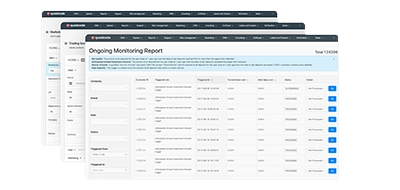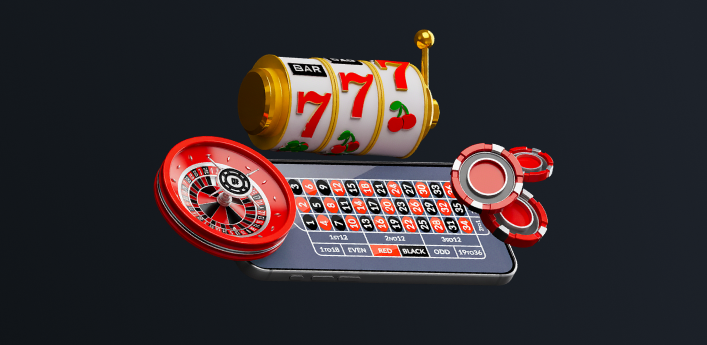กลับ
Contents
เทียน Heikin Ashi: คำจำกัดความ ภาพรวม วิธีใช้

Vitaly Makarenko
Chief Commercial Officer

Demetris Makrides
Senior Business Development Manager
Heikin Ashi เป็นอินดิเคเตอร์ที่อิงตามแท่งเทียนเฉพาะ ซึ่งแตกต่างจากแท่งเทียนญี่ปุ่นแบบดั้งเดิม แต่ให้ภาพที่ชัดเจนกว่า เทรดเดอร์ใช้แท่งเทียน Heikin Ashi เพื่อรับสัญญาณที่แรงขึ้น ซึ่งบ่งชี้ถึงการเปลี่ยนแปลงแนวโน้มที่อาจเกิดขึ้น
ตัวบ่งชี้ทำงานอย่างไร และมีกลยุทธ์การซื้อขายหลักๆ อะไรบ้างตามแท่งเทียน Heikin Ashi?
ประวัติของตัวบ่งชี้ Heikin Ashi
คำว่า "เฮคิน อาชิ" แปลจากภาษาญี่ปุ่นว่า "แท่งกลาง/แท่งกลางเฉลี่ย" อินดิเคเตอร์ชนิดนี้ปรากฏขึ้นในช่วงปี ค.ศ. 1700 และผู้สร้างแท่งเทียนเฮคิน อาชิ คือ มุเนะฮิสะ ฮอมมะ พ่อค้าข้าวจากเมืองซากาตะ มุเนะฮิสะยังเป็นผู้ริเริ่มแผนภูมิแท่งเทียนแบบดั้งเดิมด้วย ซึ่งเป็นเหตุผลที่เฮคิน อาชิ จึงถูกเข้าใจว่าเป็นแท่งเทียนญี่ปุ่นที่จัดรูปแบบใหม่
ความแตกต่างระหว่างแท่งเทียน Heikin Ashi และแท่งเทียนญี่ปุ่น
แท่งเทียนแบบดั้งเดิมของญี่ปุ่นจะให้ข้อมูลต่อไปนี้แก่ผู้ซื้อขาย:
- ราคาเปิด;
- ราคาปิด;
- ราคาขั้นต่ำ;
- ราคาสูงสุด
ราคาเปิดและราคาปิดจะแสดงโดยตัวแท่งเทียน ส่วนเงาจะแสดงราคาต่ำสุดและสูงสุดภายในกรอบเวลาที่กำหนด
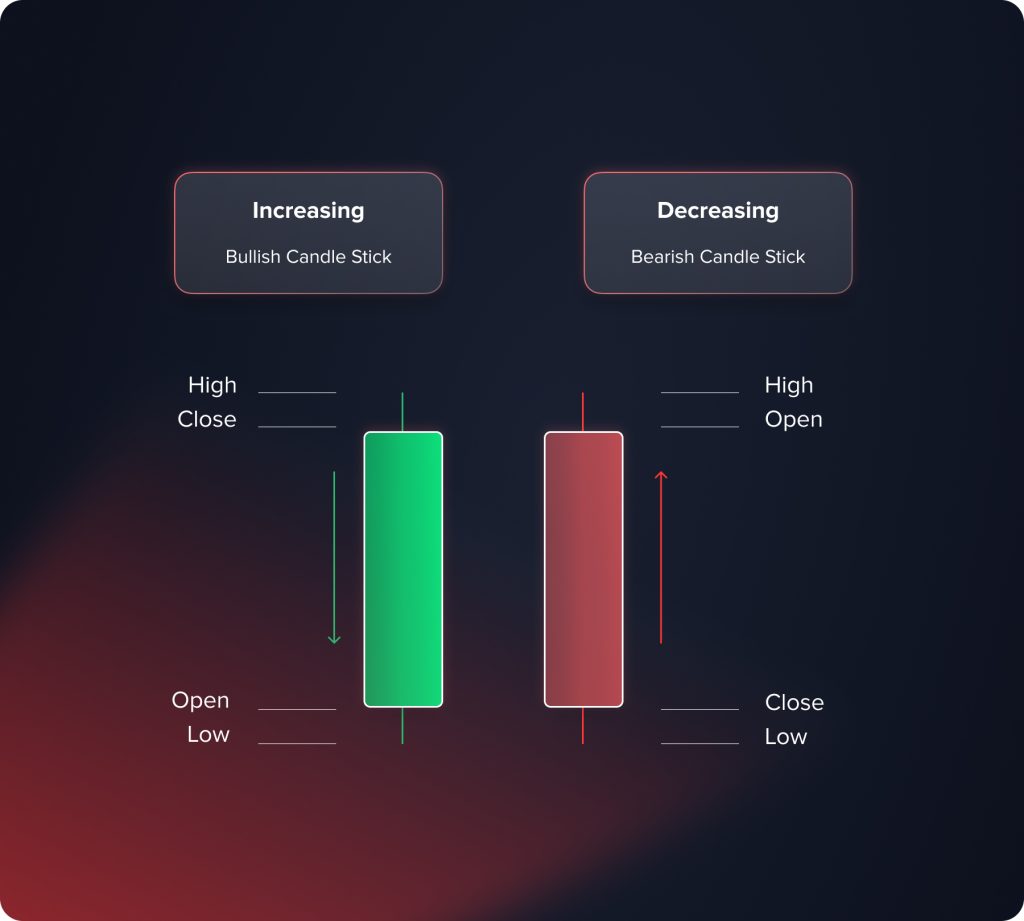
เมื่อตลาดมีความผันผวนสูง แท่งเทียนขาขึ้นและขาลงจะสลับกันบนกราฟ ซึ่งทำให้ยากต่อการระบุแนวโน้มปัจจุบัน แท่งเทียน Heikin Ashi แบบดัดแปลงจะช่วยแก้ปัญหานี้ได้
แทนที่จะระบุราคาเปิด ราคาปิด ราคาต่ำสุด และราคาสูงสุด Heikin Ashi จะแสดงความหมายโดยเฉลี่ยของตัวบ่งชี้ทั้งหมด
ภาพต่อไปนี้แสดงให้เห็นถึงวิธีการสร้างแท่งเทียนแบบดั้งเดิมและ Heikin Ashi สำหรับกราฟ EUR/USD (กรอบเวลา D1) แท่งเทียน Heikin Ashi มีความนุ่มนวลกว่า ไม่มีช่องว่าง และเทรดเดอร์อาจมองข้ามสัญญาณรบกวนจากตลาด
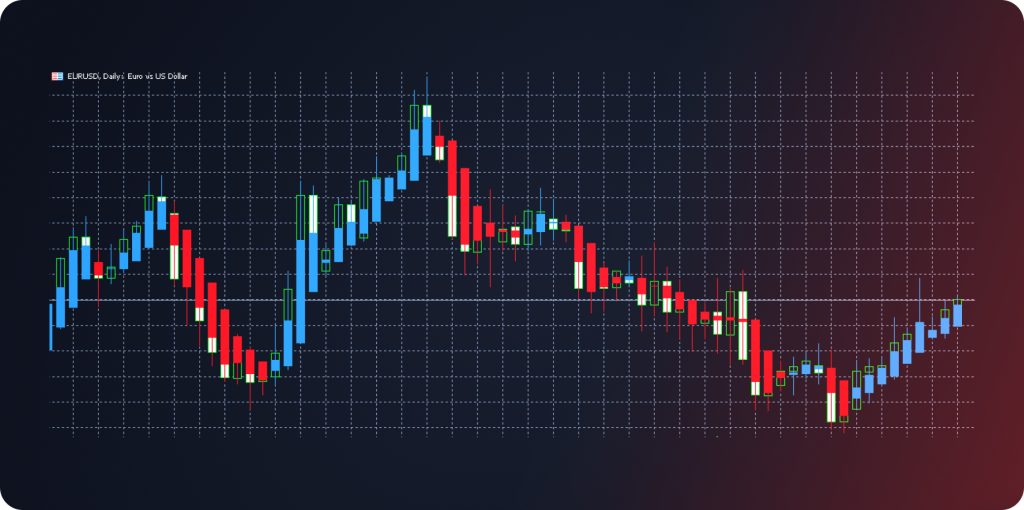
เทียน Heikin Ashi ถูกสร้างขึ้นตามสูตรต่อไปนี้:
- ราคาเปิด = (ราคาเปิดของแท่งก่อนหน้า + ราคาปิดของแท่งก่อนหน้า) / 2;
- ราคาปิด = (ราคาเปิด + ราคาสูงสุด + ราคาต่ำสุด + ราคาปิด) / 4;
- ราคาสูงสุด = (ราคาสูงสุดที่นำมาจากราคาสูงสุด, เปิด หรือ ปิด);
- ราคาขั้นต่ำ = (ราคาต่ำสุดที่นำมาจากราคาต่ำสุด, ราคาเปิด, ราคาปิด)
เทรดเดอร์มักเปรียบเทียบตัวบ่งชี้ Heikin Ashi กับค่าเฉลี่ยเคลื่อนที่ เนื่องจากเครื่องมือทั้งสองให้ข้อมูลตลาดที่ราบรื่นแก่เทรดเดอร์ โดยไม่คำนึงถึงความผันผวนและสัญญาณรบกวนในระยะสั้น
สัญญาณเฮคิน อาชิ
การใช้เทียน Heikin Ashi ช่วยให้เทรดเดอร์ได้รับข้อมูลสำคัญดังต่อไปนี้: ทิศทางของแนวโน้มตลาดปัจจุบัน จุดเริ่มต้นและจุดสิ้นสุด ซึ่งเป็นเหตุผลว่าทำไมพวกเขาจึงสามารถเปิดหรือปิดสถานะได้ จะระบุสัญญาณโดยใช้ตัวบ่งชี้นี้ได้อย่างไร?
- เมื่อราคาสินทรัพย์ปรับตัวสูงขึ้นหรือลดลงอย่างต่อเนื่อง เงาที่ต่ำที่สุดและไม่มีอยู่จริงเป็นตัวบ่งชี้ที่สำคัญของแนวโน้มที่กำลังดำเนินอยู่ ตัวอย่างเช่น ในตลาดขาขึ้น แท่งเทียน Heikin Ashi จะมีเงาที่ต่ำกว่าต่ำที่สุดหรือไม่มีเลย และในทางกลับกัน
- ระดับการเปิดของแท่งเทียนเป็นอีกหนึ่งตัวบ่งชี้สำคัญ เมื่อแนวโน้มใด ๆ มีอิทธิพลเหนือตลาด แท่งเทียนใหม่มักจะเปิดขึ้นตรงกลางของแท่งเทียนก่อนหน้า
- ควรพิจารณาสีของแท่งเทียนด้วย Heikin Ashi ใช้ข้อมูลตลาดที่ราบรื่น นี่คือเหตุผลที่แท่งเทียนสีน้ำเงิน (สีเขียว) มีอิทธิพลเหนือตลาด บ่งบอกถึงแนวโน้มขาขึ้น ในขณะที่แท่งเทียนสีแดงมีอิทธิพลเหนือตลาด บ่งบอกถึงแนวโน้มขาลง
ขนาดของแท่งเทียนช่วยให้เทรดเดอร์เข้าใจถึงความแข็งแกร่งของแนวโน้มปัจจุบัน เมื่อแท่งเทียนถัดไปมีขนาดใหญ่กว่าแท่งเทียนก่อนหน้า ความแข็งแกร่งของแนวโน้มจะเพิ่มขึ้น การลดลงของขนาดแท่งเทียนบ่งชี้ถึงการลดลงของความแข็งแกร่งของแนวโน้มและความเป็นไปได้ของการกลับตัว
ลองนำสัญญาณที่กล่าวมาข้างต้นมาใช้กับกราฟจริง ตัวอย่างเช่น เราใช้กราฟ XAU/USD (ทองคำเทียบกับดอลลาร์สหรัฐ)
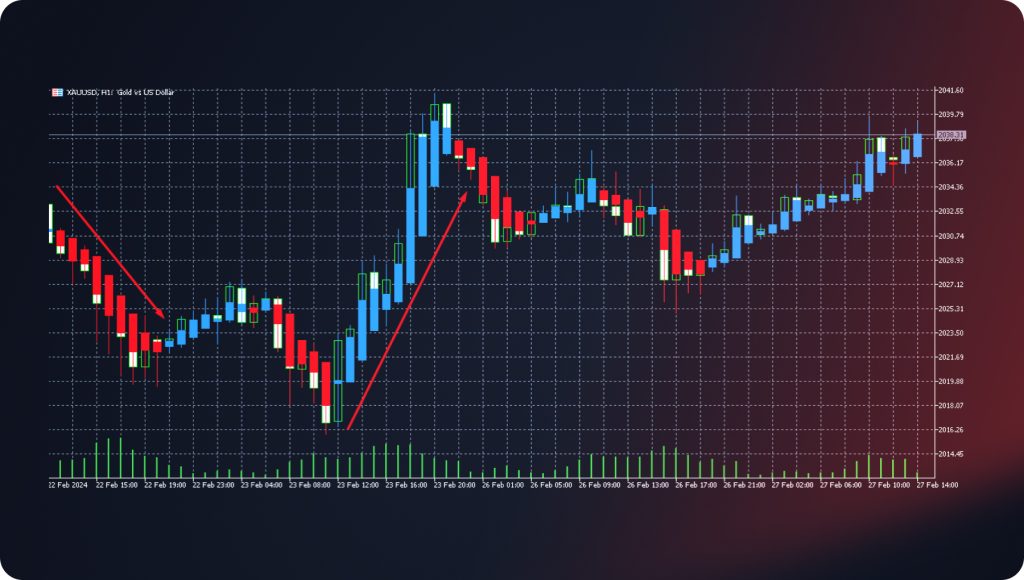
เมื่อแนวโน้มขาลงครอบงำตลาด แท่งเทียนสีแดงจะมีเงาบนน้อยที่สุดหรือไม่มีเลย เมื่อเงาบนปรากฏขึ้น แนวโน้มจะสูญเสียความแข็งแกร่ง ซึ่งหมายถึงการกลับตัวที่เป็นไปได้ นอกจากนี้ แท่งเทียน Heikin Ashi ยังแสดงการเคลื่อนไหวของราคาที่แม่นยำยิ่งขึ้นสำหรับเทรดเดอร์ ในกราฟแบบดั้งเดิม เราจะเห็นการผสมผสานระหว่างแท่งเทียนขาขึ้นและขาลง เมื่อแท่งเทียนของตราสาร Heikin Ashi มีลักษณะขาขึ้นหรือขาลงอย่างชัดเจน
แพทเทิร์น Heikin Ashi
รูปแบบกราฟเป็นหนึ่งในเครื่องมือที่ใช้กันอย่างแพร่หลายที่สุด ซึ่งช่วยให้เทรดเดอร์เข้าใจช่วงเวลาที่ดีที่สุดในการเข้าสู่ตลาด เมื่อพูดถึงแท่งเทียน Heikin Ashi รูปแบบกราฟเหล่านี้ถือเป็นสัญญาณที่แม่นยำกว่า รูปแบบกราฟแบบใดที่แพร่หลายและมีประโยชน์มากที่สุด
โดจิ
เมื่อราคาเปิดและราคาปิดเท่ากัน รูปแบบ Doji จะปรากฏขึ้น แท่งเทียนมีตัวแท่งที่ไม่มีอยู่จริง แสดงด้วยเส้นแนวนอนและเงายาวบนและล่าง รูปแบบนี้แสดงให้เห็นว่าทั้งกระทิงและหมีไม่ได้ครองตลาด Doji จัดอยู่ในประเภทของรูปแบบการกลับตัว เมื่อปรากฏขึ้นในช่วงท้ายของตลาดกระทิง เทรดเดอร์จะเปิดสถานะขาย และในทางกลับกัน
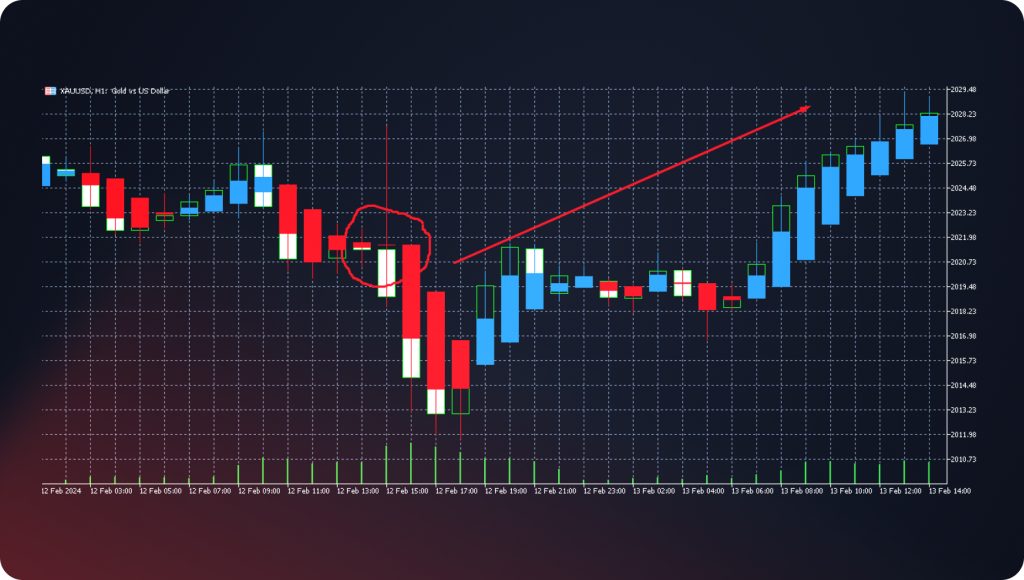
ฮารามิครอส
รูปแบบนี้ประกอบด้วยแท่งเทียนสองแท่ง และถือเป็นรูปแบบการกลับตัวด้วยเช่นกัน แท่งเทียน Harami cross ประกอบด้วยแท่งเทียนสองแท่งที่มีสีต่างกัน แท่งเทียนแท่งแรกมีตัวแท่งใหญ่ ในขณะที่แท่งเทียนแท่งถัดไปมีลักษณะคล้ายกับรูปแบบ Doji ข้อแตกต่างเพียงอย่างเดียวคือ แท่งเทียน Harami cross มีตัวแท่งเล็กสุด ไม่ใช่แค่เส้นแนวนอน โปรดทราบว่าเงาของแท่งเทียนแท่งที่สองไม่ควรตัดกับเงาของแท่งเทียนแท่งก่อนหน้า เมื่อแท่งเทียน Harami cross ปรากฏบนกราฟ เทรดเดอร์ควรเตรียมพร้อมสำหรับการกลับตัวของแนวโน้ม
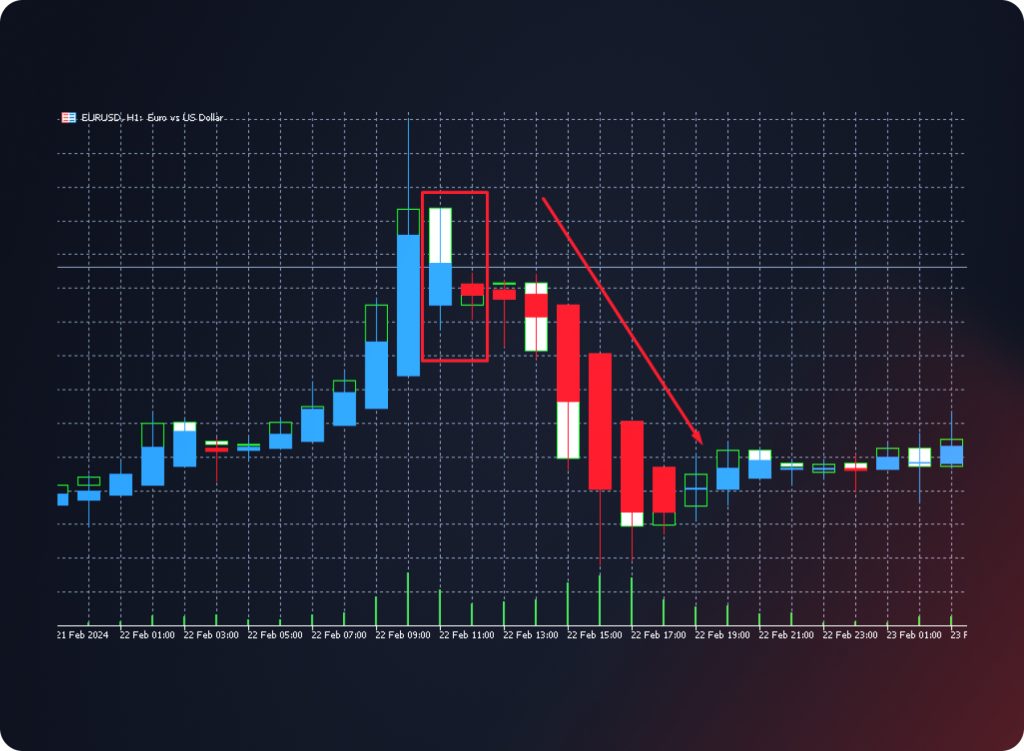
ค้อน / ชายแขวนคอ
รูปแบบแท่งเทียนนี้ประกอบด้วยแท่งเทียนที่มีตัวเทียนขั้นต่ำ เงาบนขั้นต่ำหรือไม่มีเลย และเงาล่างยาว กราฟของรูปแบบนี้มีลักษณะคล้ายค้อน เมื่อรูปแบบนี้ปรากฏในตลาดขาขึ้น จะเรียกว่า “คนแขวน” (Hanging man) เมื่อเทรดเดอร์ระบุรูปแบบค้อน (คนแขวน) ได้ พวกเขาจะเปิดสถานะในทิศทางตรงกันข้าม
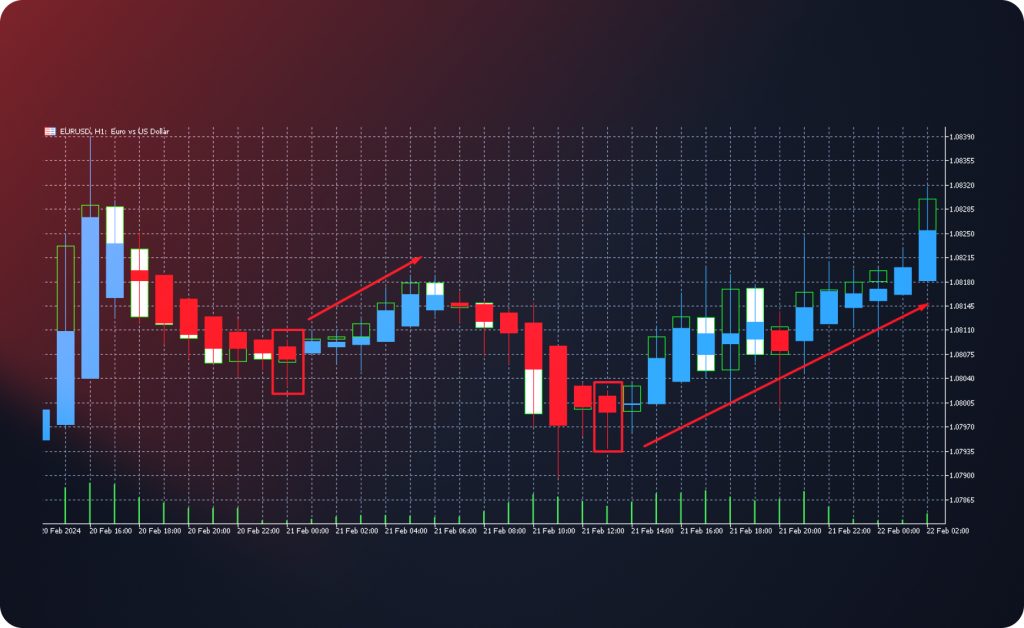
ดาวตก
รูปแบบกราฟนี้ปรากฏในตลาดขาขึ้นและบ่งชี้การกลับตัวที่ใกล้ที่สุด แท่งเทียน Shooting Star มีเงาบนยาวกว่าตัวแท่งเทียนอย่างน้อยสองเท่า เงาล่างควรหายไปหรือน้อยที่สุด (น้อยกว่า 10% ของตัวแท่งเทียน) แท่งเทียนจะเป็นสีน้ำเงิน (เขียว) เสมอ เมื่อแท่งเทียน Shooting Star ปรากฏขึ้น เทรดเดอร์จะเปิดสถานะขาย
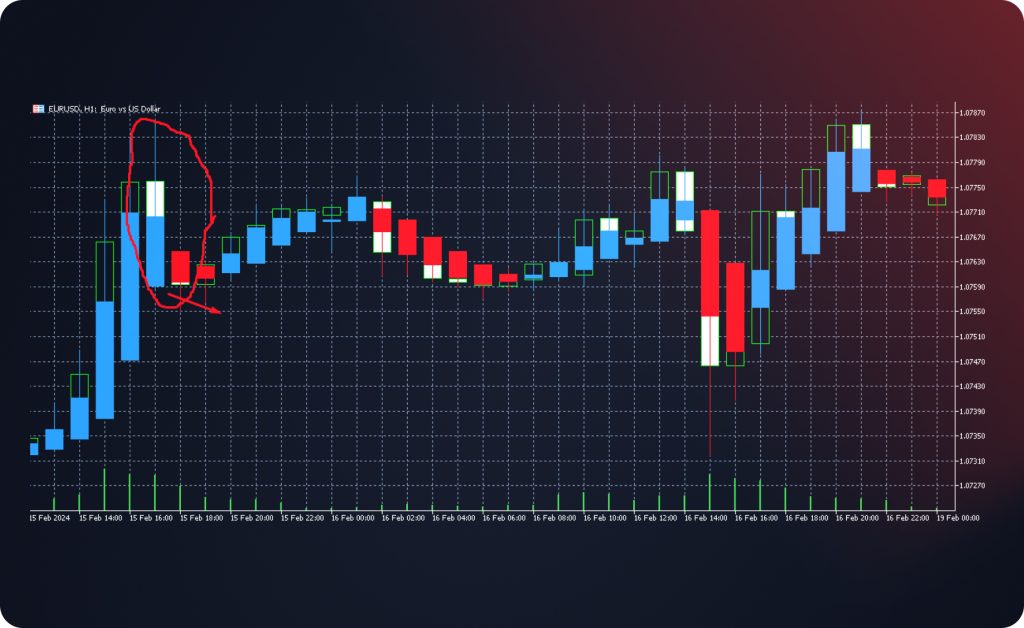
คลื่นสูง
คลื่นสูงคือแท่งเทียนที่มีเงายาวด้านบนและด้านล่างที่มีขนาดเท่ากัน แท่งเทียนเหล่านี้มีบทบาทเช่นเดียวกับรูปแบบ Doji คลื่นสูงบ่งชี้ว่าตลาดกำลังอยู่ในสภาวะสมดุลระหว่างขาขึ้นและขาลง ซึ่งเป็นสาเหตุที่ทำให้แนวโน้มก่อนหน้าสูญเสียความแข็งแกร่ง
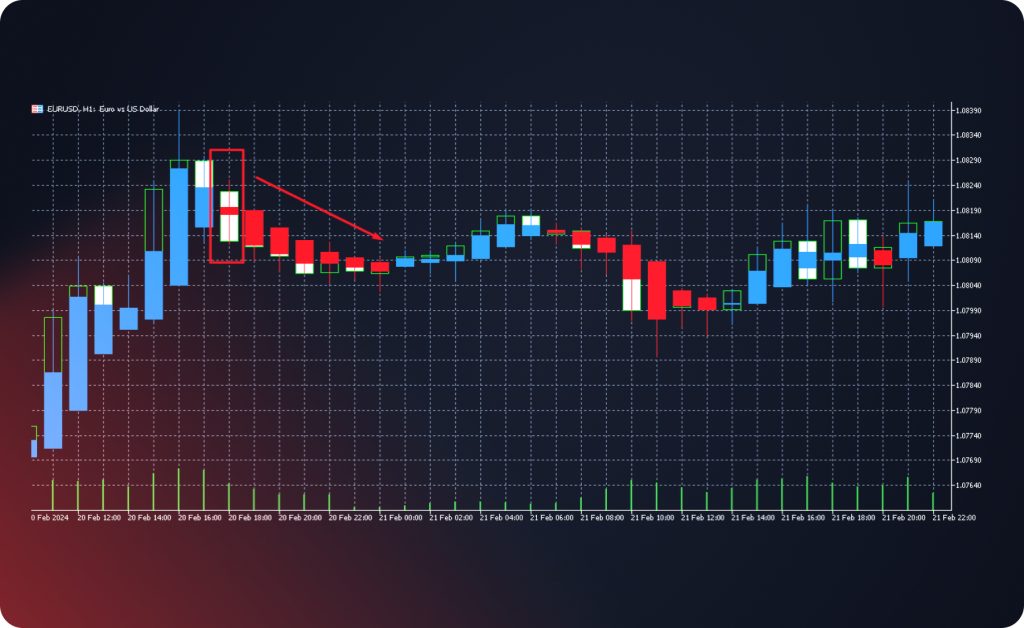
จะใช้ Heikin Ashi เพื่อระบุแนวโน้มปัจจุบันได้อย่างไร?
เทรดเดอร์ที่มีประสบการณ์จะใช้เครื่องมือ Heikin Ashi เพื่อระบุแนวโน้มตลาดปัจจุบัน ปัจจัยต่อไปนี้มีความสำคัญอย่างยิ่ง:
- ความยาวของตัวเทียนและการเปลี่ยนแปลงของมัน
- อัตราส่วนระหว่างตัวเทียนและเงาของเทียน
- ประเภทของแท่งเทียนที่มีอิทธิพล (ขาขึ้นหรือขาลง);
- ทิศทางการเคลื่อนไหวของราคา
มาทำความเข้าใจกันว่าจะใช้ปัจจัยที่กล่าวถึงเพื่อระบุแนวโน้มขาขึ้นและขาลงได้อย่างไร
แนวโน้มตลาดขาขึ้น (ตามข้อมูลของ Heikin Ashi)
เครื่องหมายต่อไปนี้แจ้งให้ผู้ซื้อขายทราบว่าแนวโน้มขาขึ้นครอบงำตลาด:
- ราคาจะสูงขึ้นไปอีก
- แท่งเทียนสีเขียว (สีน้ำเงิน) มีแนวโน้มโดดเด่นบนกราฟ
- เมื่อแท่งเทียนขาขึ้นมีขนาดใหญ่ขึ้น ความแข็งแกร่งของแนวโน้มขาขึ้นก็จะยิ่งเพิ่มขึ้น เมื่อแท่งเทียนมีขนาดเล็กลง แนวโน้มก็จะสูญเสียความแข็งแกร่ง
- เงาที่ต่ำที่สุดหรือไม่มีเลยบ่งบอกถึงแนวโน้มขาขึ้นที่แข็งแกร่ง
แนวโน้มตลาดขาลง (ตามข้อมูลของ Heikin Ashi)
เครื่องหมายต่อไปนี้แจ้งให้ผู้ซื้อขายทราบว่าแนวโน้มขาลงครอบงำตลาด:
- ราคาจะลดลงแล้ว
- แท่งเทียนสีแดงแนวโน้มขาลงกำลังครอบงำบนกราฟ
- เมื่อแท่งเทียนขาลงมีขนาดใหญ่ขึ้น ความแข็งแกร่งของแนวโน้มขาลงก็จะยิ่งเพิ่มขึ้น เมื่อแท่งเทียนมีขนาดเล็กลง แนวโน้มก็จะสูญเสียความแข็งแกร่งไป
- เงาด้านบนที่น้อยที่สุดหรือไม่มีเลย บ่งบอกถึงแนวโน้มขาลงที่แข็งแกร่ง
การวิเคราะห์แนวโน้มโดยอิงจากแท่งเทียน Heikin Ashi (คู่สกุลเงิน GBP/USD)
มาดูตัวอย่างข้อมูลข้างต้นกัน อินดิเคเตอร์ Heikin Ashi ถูกนำมาใช้กับกราฟ GBP/USD เพื่อทำความเข้าใจแนวโน้มตลาดปัจจุบันและความแข็งแกร่งของตลาด
แท่งเทียนสีน้ำเงินช่วยให้เราเข้าใจว่าแนวโน้มขาขึ้นมีอิทธิพลเหนือตลาด แท่งเทียนไม่มีเงาที่ต่ำกว่า ดังนั้นแนวโน้มจึงค่อนข้างแข็งแกร่ง ในทางกลับกัน ขนาดของแท่งเทียนจะเพิ่มขึ้นจนถึง 5ไทย candle, and ไทยen bodies are getting smaller. Such a tendency may indicate ไทยat ไทยe bullish trend becomes weaker.
Heikin Ashi เป็นตัวบ่งชี้ที่มีประโยชน์ แต่ผู้ค้าที่มีประสบการณ์จะใช้ร่วมกับเครื่องมืออื่นเพื่อรับสัญญาณที่แม่นยำยิ่งขึ้น
การผสมผสานของ Heikin Ashi กับเครื่องมือวิเคราะห์ทางเทคนิคอื่นๆ
การผสมผสานระหว่าง Heikin Ashi และค่าเฉลี่ยเคลื่อนที่
เทรดเดอร์บางรายใช้ Heikin Ashi ร่วมกับอินดิเคเตอร์โมเมนตัม ตัวอย่างเช่น คุณอาจเพิ่มอินดิเคเตอร์ค่าเฉลี่ยเคลื่อนที่ (Moving Average Indicator) ลงในกราฟ (เส้น SMA ที่มีระยะเวลา 50) เมื่อแท่งเทียน Heikin Ashi ตัดกับเส้น SMA 50 คุณสามารถเปิดสถานะได้ดังนี้:
- เปิดสถานะซื้อเมื่อแท่งเทียน Heikin Ashi สีเขียว (สีน้ำเงิน) ตัดผ่านเส้น SMA 50 จากล่างขึ้นบน
- เปิดสถานะขายเมื่อแท่งเทียน Heikin Ashi สีแดงตัดผ่านเส้น SMA 50 จากบนลงล่าง
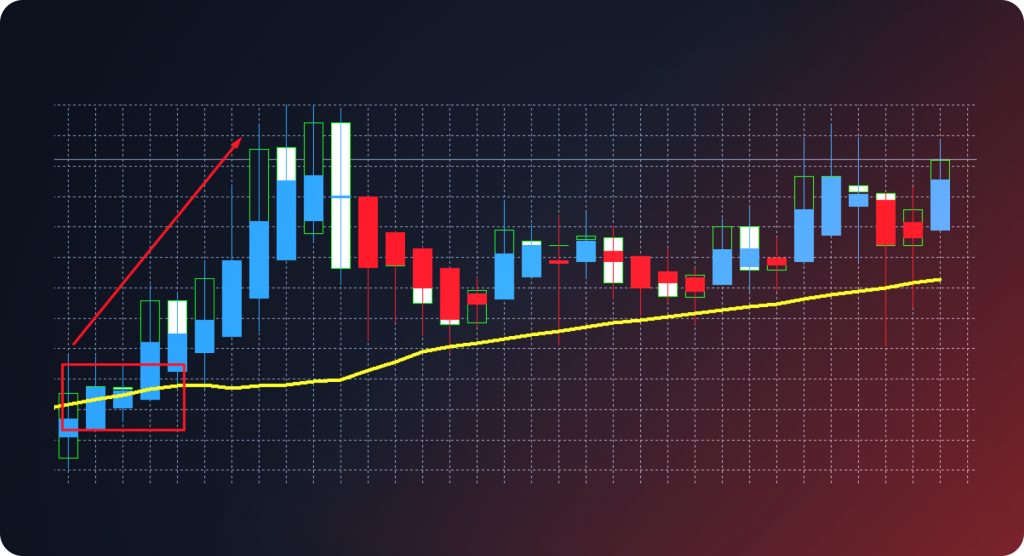
การผสมผสานระหว่าง Ichimoku Cloud และ Heikin Ashi
เพิ่มคลาวด์ Ichimoku ลงในกราฟโดยใช้การตั้งค่าเริ่มต้น (9, 26, 52) ควรพิจารณาเงื่อนไขต่อไปนี้เมื่อเข้าสู่ตลาด:
- เปิดสถานะซื้อเมื่อแท่งเทียนหลุดออกจากกลุ่มเมฆคุโมะและปิดเหนือกลุ่มเมฆ แท่งเทียนเท็นคังสูงกว่าแท่งเทียนคิจุน แท่งเทียนชิโคะสแปนสูงกว่ากราฟราคาและอยู่ในแนวโน้มขาขึ้น แท่งเทียนเซ็นโคะสแปน A สูงกว่าแท่งเทียนเซ็นโคะสแปน B แท่งเทียนเฮคินอาชิมีแนวโน้มขาขึ้น (สีเขียวหรือสีน้ำเงิน)
- เปิดสถานะขายเมื่อแท่งเทียนหลุดออกจากกลุ่มเมฆคุโมะและปิดตัวลง แท่งเทียนเท็นคังเซนต่ำกว่าคิจุนเซน แท่งเทียนชิโคสแปนต่ำกว่ากราฟราคาและอยู่ในแนวโน้มขาลง แท่งเทียนเซ็นโคสแปนเอต่ำกว่าแท่งเทียนเซ็นโคสแปนบี แท่งเทียนเฮคินอาชิมีแนวโน้มขาลง (สีแดง)
ข้อดีและข้อเสียของตัวบ่งชี้ Heikin Ashi
ข้อดีของ Heikin Ashi มีดังนี้:
- ตัวบ่งชี้นี้ใช้ระบบภาพที่เรียบง่ายและมีประสิทธิภาพ
- ตัวบ่งชี้ดังกล่าวถือเป็นโซลูชั่นที่สมบูรณ์แบบสำหรับกรอบเวลาที่ยาวนาน
- แท่งเทียน Heikin Ashi สามารถระบุสีได้ง่าย และเทรดเดอร์ไม่จำเป็นต้องจำการผสมผสานที่ซับซ้อน
ข้อเสียของ Heikin Ashi มีดังต่อไปนี้:
- ตัวบ่งชี้ไม่ตรงกับรูปแบบการซื้อขายตามแรงกระตุ้น
- Heikin Ashi มอบสัญญาณที่แม่นยำยิ่งขึ้นให้กับผู้ซื้อขายเมื่อใช้กับกรอบเวลา H4 หรือสูงกว่า
- ต้องรวมตัวบ่งชี้ Heikin Ashi เข้ากับตัวบ่งชี้อื่น ๆ ก่อนเปิดตำแหน่ง
บรรทัดล่าง
Heikin Ashi เป็นอินดิเคเตอร์ที่เทรดเดอร์มืออาชีพใช้กันอย่างแพร่หลายเพื่อระบุแนวโน้มปัจจุบัน โดยพิจารณาจากสีแท่งเทียน ขนาดแท่งเทียน และเงาของแท่งเทียน จะทำให้สามารถเข้าใจแนวโน้มที่ครอบงำตลาดและความแข็งแกร่งของตลาดได้ การผสมผสาน Heikin Ashi เข้ากับเครื่องมืออื่นๆ ช่วยให้เทรดเดอร์สามารถส่งสัญญาณที่แม่นยำยิ่งขึ้นในการเปิดสถานะซื้อและขาย
อัปเดต:
19 ธันวาคม 2567
